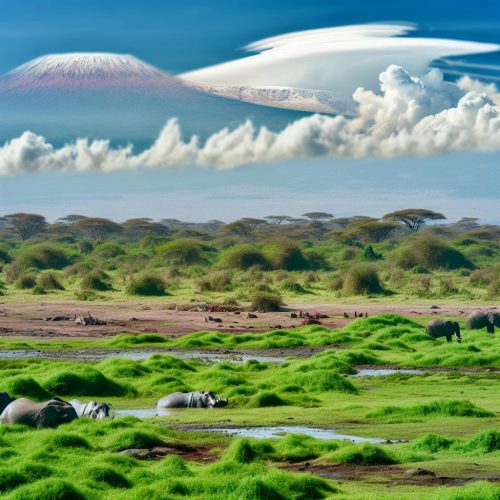Amboseli National Park Overview
Amboseli National Park, located in the southern part of Kenya, is renowned for its breathtaking landscapes and diverse wildlife. This unique national park spans roughly 392 square kilometers and is particularly famous for offering exceptional views of Mount Kilimanjaro, which holds the distinction of being the highest peak in Africa. Serving as an outstanding destination for those passionate about safaris, the park presents a distinctive combination of natural beauty, challenging terrain, and rich biodiversity that appeals to a wide range of nature enthusiasts.
Wildlife at Amboseli National Park
Amboseli National Park is a haven for wildlife enthusiasts due to its vast array of animal species. This makes it an ideal location for animal watching. Among the animals that are frequently observed are the African elephants. These magnificent creatures are a central attraction, admired for both their large size and remarkable populations in the area. In addition to elephants, visitors have the opportunity to view a variety of other wildlife. Lions roam the plains, showcasing their commanding presence, while cheetahs add a touch of grace and speed to the ecosystem. The park also hosts buffaloes, whose formidable build and herding behavior are noteworthy.
Zebras are often seen grazing the savanna, their distinctive stripes creating stunning visual patterns against the backdrop of the landscape. Giraffes, with their elongated necks and legs, traverse the park with an elegant gait. Furthermore, Amboseli is a bird watcher’s paradise, boasting numerous bird species, each contributing to the park’s vibrant soundscape and beauty. The conservation of these species is integral to maintaining the ecological balance within the park, and ongoing efforts are in place to ensure their survival.
Conservation Efforts
Amboseli National Park is actively involved in several conservation endeavors aimed at protecting its natural habitat and the myriad species residing within its borders. These conservation initiatives are essential for safeguarding the delicate ecosystems of the park. One of the primary focuses of these efforts is to mitigate human-wildlife conflicts, which can arise due to various factors, including poaching and habitat encroachment. The presence of elephants within the park has brought attention to the necessity of these efforts, as their populations are sometimes threatened by illegal hunting practices.
Conservation organizations working within Amboseli aim to address these issues by implementing strategies that foster coexistence between humans and wildlife. They emphasize the importance of protecting elephants and other at-risk species to preserve Amboseli’s biodiversity. Steps are being taken to create sustainable solutions that balance the needs of the local communities with those of the wildlife. These efforts are supported by educational programs and community involvement, fostering an environment where wildlife and people can thrive together. To learn more about these vital conservation projects, visit the detailed information available at Amboseli Conservation Projects.
Mount Kilimanjaro Views
Among the most enchanting elements of Amboseli National Park is its unrivaled views of Mount Kilimanjaro. This iconic mountain, although geographically situated in Tanzania, provides some of its most spectacular vistas from within the park. The opportunity to witness the snow-capped peak against the expansive African sky is a draw for many visitors seeking a serene yet stunning natural setting.
Clear days in the park, particularly in the early morning or during late afternoon hours, offer the best chances to capture the magical sight of Mount Kilimanjaro. Its towering presence serves as a testament to the geological and natural wonders of Africa. For photographers and nature lovers alike, these moments present an invaluable opportunity to capture the mountain’s beauty from various strategic locations throughout the park. Therefore, a visit to Amboseli allows guests to not only enjoy the rich wildlife but also indulge in one of nature’s most breathtaking landscapes.
Best Time to Visit Amboseli National Park
For those planning a visit to Amboseli National Park, timing plays a crucial role in optimizing the experience. The most favorable time to explore the park is during the dry seasons, which occur from June to October and again from January to February. During these periods, the weather conditions are particularly conducive to game viewing. The lack of rain means that the animals are more likely to gather around the limited water sources, providing excellent opportunities for observation and photography.
Additionally, these months often present clearer skies, enhancing the likelihood of unobstructed views of Mount Kilimanjaro. The dry seasons thus allow for the dual experience of observing abundant wildlife while also enjoying the majestic views of Africa’s highest peak. Planning a visit during these times ensures that visitors can fully appreciate the unique combination of awe-inspiring landscapes and rich biodiversity that Amboseli National Park has to offer.
For more comprehensive information and assistance with planning a visit to Amboseli National Park, interested individuals can consult the official site of the Kenya Wildlife Service – Amboseli National Park. This resource provides helpful insights and the guidance necessary to make the most of a trip to this exceptional safari destination.
